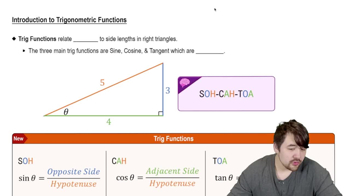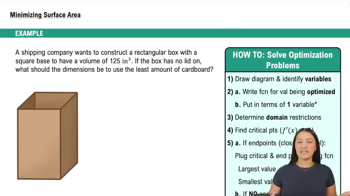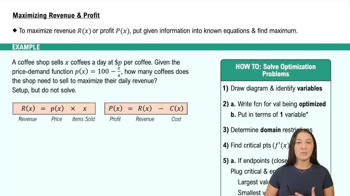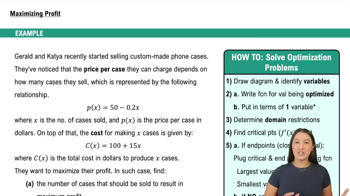Table of contents
- 0. Functions7h 52m
- Introduction to Functions16m
- Piecewise Functions10m
- Properties of Functions9m
- Common Functions1h 8m
- Transformations5m
- Combining Functions27m
- Exponent rules32m
- Exponential Functions28m
- Logarithmic Functions24m
- Properties of Logarithms34m
- Exponential & Logarithmic Equations35m
- Introduction to Trigonometric Functions38m
- Graphs of Trigonometric Functions44m
- Trigonometric Identities47m
- Inverse Trigonometric Functions48m
- 1. Limits and Continuity2h 2m
- 2. Intro to Derivatives1h 33m
- 3. Techniques of Differentiation3h 18m
- 4. Applications of Derivatives2h 38m
- 5. Graphical Applications of Derivatives6h 2m
- 6. Derivatives of Inverse, Exponential, & Logarithmic Functions2h 37m
- 7. Antiderivatives & Indefinite Integrals1h 26m
- 8. Definite Integrals4h 44m
- 9. Graphical Applications of Integrals2h 27m
- 10. Physics Applications of Integrals 2h 22m
5. Graphical Applications of Derivatives
Applied Optimization
Problem 4.5.55a
Textbook Question
Two poles of heights m and n are separated by a horizontal distance d. A rope is stretched from the top of one pole to the ground and then to the top of the other pole. Show that the configuration that requires the least amount of rope occurs when Θ₁ = Θ₂ (see figure). <IMAGE>
 Verified step by step guidance
Verified step by step guidance1
Consider the two poles with heights m and n, separated by a horizontal distance d. Let the point where the rope touches the ground be P, dividing the distance d into two segments: x and (d-x).
The rope forms two right triangles. For the first triangle, with the pole of height m, the angle Θ₁ is formed between the rope and the ground. Similarly, for the second triangle, with the pole of height n, the angle Θ₂ is formed.
Using trigonometry, express the lengths of the rope segments in terms of x, m, n, and d. The length of the rope from the top of the first pole to the ground is given by the hypotenuse of the first triangle: √(x² + m²). Similarly, the length of the rope from the ground to the top of the second pole is: √((d-x)² + n²).
The total length of the rope is the sum of these two segments: L(x) = √(x² + m²) + √((d-x)² + n²). To minimize the total length of the rope, we need to find the value of x that minimizes L(x).
To find the minimum, take the derivative of L(x) with respect to x and set it to zero. This will give the condition for the minimum length. Solving this will show that the configuration with the least amount of rope occurs when Θ₁ = Θ₂, meaning the angles are equal, which is the condition for the minimum length of the rope.
 Verified video answer for a similar problem:
Verified video answer for a similar problem:This video solution was recommended by our tutors as helpful for the problem above
Video duration:
12mPlay a video:
Was this helpful?
Key Concepts
Here are the essential concepts you must grasp in order to answer the question correctly.
Optimization
Optimization in calculus involves finding the maximum or minimum values of a function. In this context, we are looking to minimize the length of the rope stretched between two poles. This often requires setting up a function that represents the total length of the rope and then using techniques such as derivatives to find critical points where the length is minimized.
Recommended video:

Intro to Applied Optimization: Maximizing Area
Trigonometric Functions
Trigonometric functions, such as sine and cosine, relate the angles of a triangle to the lengths of its sides. In this problem, the angles Θ₁ and Θ₂ are crucial for determining the lengths of the segments of the rope. Understanding how to express the lengths of these segments in terms of the angles will help in formulating the optimization problem.
Recommended video:

Introduction to Trigonometric Functions
Symmetry in Geometry
Symmetry in geometry refers to a situation where a configuration remains unchanged under certain transformations. In this problem, the configuration that minimizes the rope length occurs when the angles Θ₁ and Θ₂ are equal, indicating a symmetric arrangement. Recognizing this symmetry can simplify the analysis and lead to a more straightforward solution.
Recommended video:

Changing Geometries

 1:13m
1:13mWatch next
Master Intro to Applied Optimization: Maximizing Area with a bite sized video explanation from Callie
Start learningRelated Videos
Related Practice








